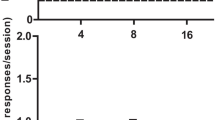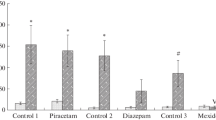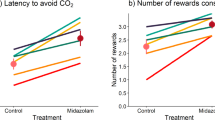Abstract
The anxiogenic nature of the interoceptive discriminative stimulus induced by pentylenetetrazole (PTZ) was investigated by examining the discriminatory behaviour of PTZ conditioned pigs during a conditioned emotional response (CER). A CER was induced in a non-operant situation, by pairing a tone stimulus with the application of a mild, non-injurious electric shock. Subsequent presentation of the conditioned tone stimulus alone produced a generalisation to the PTZ cue. This generalisation of the conditioned emotional state (CES) to the PTZ cue was antagonised by pretreatment with diazepam (0.5 mg/kg, PO; 30 min). The PTZ stimulus was also antagonised by diazepam (0.5 mg/kg, PO; 30 min) but not by an anticonvulsant dose of ethosuximide (30 mg/kg, PO; 1–3 h), providing further confirmation of the anxiogenic nature of the PTZ cue. Our results demonstrate the validity of the PTZ discrimination paradigm in pigs as a test of anxiety.
Similar content being viewed by others
References
Andrews J, Turski L, Stephens DN (1989) Does the pentylenetetrazole (PTZ) cue reflect PTZ-induced kindling or PTZ-induced anxiogenesis? Drug Dev Res 16:247–256
Baldwin BA, Stephens DB (1973) The effects of conditioned behaviour and environmental factors on plasma corticosteroid levels in pigs. Physiol Behav 10:267–274
Blackman DE (1972) Conditioned anxiety and operant behaviour. In: Gilbert RM, Keehn JP (eds) Schedule effects drugs, drinking and aggression. University of Toronto Press, Toronto, pp 26–49
Carey MP, Fry JP, White DG (1990) Anxiety and the discriminative stimulus induced by pentylenetetrazole in the pig. Psychopharmacology 101 [S9] 253
Carey MP, Fry JP, White DG (1992) The detection of changes in psychological state using a novel pharmacological conditioning procedure. J Neurosci Methods 43:69–76
Emmett-Oglesby MW, Mathis DA, Lal H (1987) Diazepam tolerance and withdrawal assessed in an animal model of subjective drug effects. Drug Dev Res 11:145–156
Emmett-Oglesby MW, Mathis DA, Moon RTY, Lal H (1990) Animal models of drug withdrawal symptoms. Psychopharmacology 101: 292–309
Estes WK, Skinner BF (1941) Some quantitative properties of anxiety. J Exp Psychol 29: 390–400
Lal H, Emmett-Oglesby MW (1983) Behavioral analogues of anxiety: animal models. Neuropharmacology 22:1423–1441
Lal H, Fielding S (1985) Antagonism of discriminative stimuli produced by anxiogenic drugs as a novel approach to bioassay of anxiolytics. Drug Dev Res 4:3–21
Lane JD, Crenshaw CM, Guerin GF, Cherek DR, Smith JE (1982a) Changes in biogenic amine and benzodiazepine receptors correlated with conditioned emotional response and its reversal by diazepam. Eur J Pharmacol 83:183–190
Lane JD, Sands MP, Freeman ME, Cherek DR, Smith JE (1982b) Amino acid neurotransmitter utilisation in discrete rat brain regions is correlated with conditioned emotional response. Pharmacol Biochem Behav 16:329–340
Lauener H (1963) Conditioned suppression in rats and the effect of pharmacological agents thereon. Psychopharmacology 4:311–325
Millenson JR, Leslie J (1974) The conditioned emotional response (CER) as a baseline for the study of anti-anxiety drugs. Neuropharmacology 13:1–9
Rall TW, Schleifer LS (1985) Drugs effective in the therapy of the epilepsies. In: Goodman AG, Gilman LS (eds) The pharmacological basis of therapeutics, 7th edn. Macmillan, New York, pp 446–472
Rodin E (1958) Metrazol tolerance in a “normal” volunteer population. Electroencephalography 10:433–446
Shearman GT, Lal H (1979) Discriminative stimulus properties of pentylenetetrazole and bemegride: some generalisation and antagonism tests. Psychopharmacology 64:315–319
Shearman GT, Lal H (1980) Generalisation and antagonism studies with convulsant, GABAergic and anticonvulsant drugs in rats trained to discriminate pentylenetetrazole from saline. Neuropharmacology 19:473–479
Stephens DN, Shearman GT, Kehr W (1984) Discriminative stimulus properties ofβ-carbolines characterised as agonists and inverse agonists at central benzodiazepine receptors. Psychopharmacology 83:233–239
Thiebot M-H, Hamon M, Soubrié P (1984) Serotonergic neurones and anxiety-related behaviour in rats. In: Zarifian E, Trimble M (eds) Psychopharmacology of the limbic system. Wiley, New York, pp 164–173
Vellucci SV, Martin PJ, Everitt BJ (1988) The discriminative stimulus produced by pentylenetetrazole: effects of systemic anxiolytics and anxiogenics, aggressive defeat and midazolam or muscimol infused into the amygdala. J Psychopharmacol 2:80–93
Author information
Authors and Affiliations
Rights and permissions
About this article
Cite this article
Carey, M.P., Fry, J.P. A behavioural and pharmacological evaluation of the discriminative stimulus induced by pentylenetetrazole in the pig. Psychopharmacology 111, 244–250 (1993). https://doi.org/10.1007/BF02245531
Received:
Revised:
Issue Date:
DOI: https://doi.org/10.1007/BF02245531




